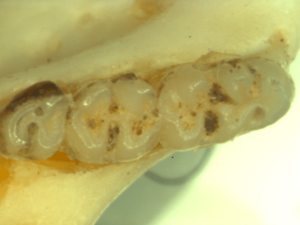Hummelinck's vesper mouse facts for kids
Quick facts for kids Hummelinck's vesper mouse |
|
|---|---|
 |
|
| Lower molar row of the holotype of Calomys hummelincki (RMNH 15994). First molar is to the right. | |
| Conservation status | |
| Scientific classification | |
| Genus: |
Calomys
|
| Species: |
hummelincki
|
The Hummelinck's vesper mouse (scientific name: Calomys hummelincki) is a small rodent that belongs to the Cricetidae family. This family includes many types of mice and hamsters.
This little mouse can be found in several countries. Its home includes Aruba, Brazil, Colombia, the Netherlands Antilles, and Venezuela. It was first described by a scientist named Husson in 1960.
Contents
Meet the Hummelinck's Vesper Mouse
The Hummelinck's vesper mouse is a fascinating creature. It's a type of mouse that lives in specific parts of South America and the Caribbean. Like all rodents, it has front teeth that keep growing throughout its life. This means it needs to chew on things to keep its teeth at a good length.
What Does It Look Like?
Hummelinck's vesper mice are small, typical-looking mice. They have soft fur and a long tail. Their size helps them move quickly through their environment.
Size and Fur
These mice are usually about 8 to 12 centimeters (3 to 5 inches) long, not including their tail. Their tail can be just as long as their body. They often have brownish or grayish fur on their backs. Their bellies are usually lighter, sometimes white or cream-colored. This coloring helps them blend in with their surroundings.
Where Does It Live?
The Hummelinck's vesper mouse prefers certain types of habitats. It lives in areas that provide good cover and food. These habitats can vary slightly across the different countries where it is found.
Its Home Environment
You can often find these mice in dry, open areas. They like grasslands, savannas, and sometimes even rocky places. They might also live in areas with scattered bushes or trees. These environments offer them places to hide from predators and find food. They build their nests in burrows or under rocks and logs.
What Does It Eat?
Like many small rodents, the Hummelinck's vesper mouse is an omnivore. This means it eats both plants and small animals. Its diet helps it get all the energy it needs to survive.
Food Choices
Their main diet often includes seeds, grasses, and other plant parts. They might also eat insects, which provide them with important protein. They are good at finding food in their environment. They use their excellent sense of smell and hearing to locate tasty treats.
Life and Habits
These mice are mostly active at night. This is called being nocturnal. Being active at night helps them avoid many predators that hunt during the day.
Night Life
During the day, Hummelinck's vesper mice usually rest in their burrows or hidden spots. When night falls, they come out to search for food. They are very quick and agile. This helps them escape danger. They also have good eyesight in low light.
Reproduction and Life Cycle
The reproduction of these mice is similar to other small rodents. They have litters of young after a short pregnancy. The babies are born helpless and need their mother's care. They grow quickly and become independent in a few weeks. This fast life cycle helps their populations grow.
Protecting This Mouse
The Hummelinck's vesper mouse is currently listed as "Least Concern" by the International Union for Conservation of Nature (IUCN). This means its population is stable and not immediately threatened. However, it's still important to protect its habitat.
Why It's Important
Every species plays a role in its ecosystem. Hummelinck's vesper mice help spread seeds and are a food source for larger animals. This includes owls, snakes, and small carnivores. Protecting them helps keep the natural balance of their habitats.
How We Help
Conservation efforts focus on preserving their natural habitats. This includes protecting grasslands and savannas from too much development. Learning more about these mice also helps scientists understand how to best protect them and their environment.
See also
 In Spanish: Calomys hummelincki para niños
In Spanish: Calomys hummelincki para niños


